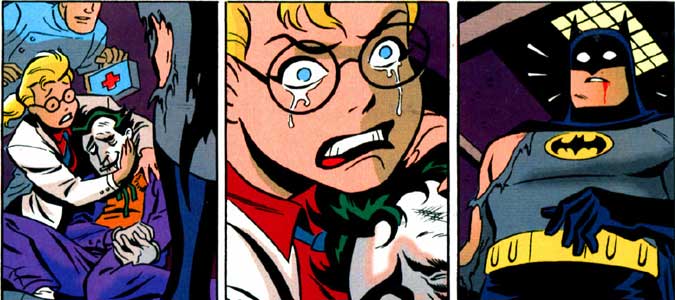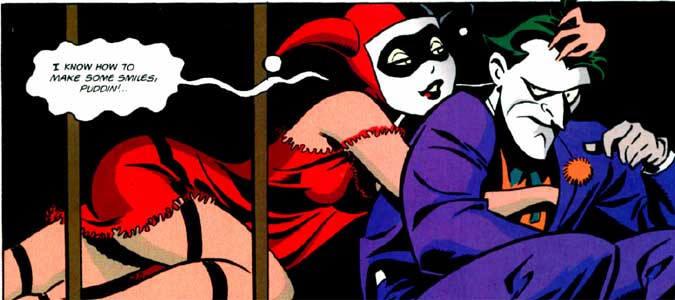This page may contain one or more affiliate links, which means that if you purchase a product through that link, I may receive compensation. The links will be identified with the text "affiliate link". Click to learn more.
The 1994 Eisner Award-winning graphic novel “The Batman Adventures: Mad Love,” centered around the Joker and Harley Quinn’s relationship from its origins at Arkham Asylum. This DC Comics masterpiece, written by Paul Dini and illustrated by Bruce Timm, takes place in the Batman: The Animated Series world we all know and love. The story of “Mad Love” became so popular that it was adapted into an episode of “The New Batman Adventures,” specifically Season 2, Episode 11.
We all love the Joker’s girlfriend who teams up with her “puddin” in Gotham City, but not until “Mad Love” do we get to see the details of Dr. Harleen Quinzel’s origin story and how she transformed from a psychologist into the sexy Harley Quinn that tries to seduce the Clown Prince of Crime. Besides learning Harley Quinn’s real name, we also get to see her inside see-through lingerie while dreaming of making babies with the Joker, touching on themes of codependency in their relationship.
The comic book is not only easy to understand, nor is it well illustrated, but is entertaining for all ages, and that is no easy feat. Because I was never thrilled with the Batman: The Animated Series style of artwork (you know, with the sharp edges and square jaws and stuff) I never would have read “Mad Love” if it were not for its tremendous popularity. This is no small testament to the brilliance of Bruce Timm’s art style, which perfectly captures the noir atmosphere of Batman’s world.

The Joker and Harley Quinn have a shaky relationship in “Mad Love,” causing Harley to recall her origin and decide to try and catch Batman by herself to prove herself capable. She succeeds, but to her dismay, the Joker is disappointed at the thought that his girlfriend would succeed where he failed. This dynamic showcases the underlying domestic violence and toxic nature of their bond, a theme that has been further explored in adaptations like “Batman: Arkham Asylum” and “Batman: Arkham Origins.”
Although the brilliant and entertaining story naturally helped the success of this classic Batman Adventures tale, it would have been meaningless without the friction between the Joker and Harley Quinn. The pair has historically made for the best stories within the animated series and comic books.
If you are able to find the graphic novel, (affiliate link) you would be wise to read it from cover to cover. “Mad Love” has since been released as a deluxe edition and has inspired various adaptations, including a motion comic and novelization. It remains a cornerstone of the Batman mythos, showcasing why The Dark Knight’s rogues gallery is among the best in comic book history.
The novel is a must-read for any fan of the Caped Crusader, offering a deep dive into one of his most complex and fascinating adversaries. Whether you’re a longtime Batman enthusiast or new to the world of Gotham City, this comic book provides a perfect entry point into the psychological complexities of Batman’s universe.
A love story built on mutual manipulation and abuse
What Mad Love shows us isn’t a romantic Joker and Harley Quinn tale—it’s a masterclass in how abusers operate. The Joker, Gotham City’s Clown Prince of Crime, follows the classic domestic abuse playbook: tension, explosion, honeymoon phase, repeat. He verbally tears Harley down, physically assaults her, and literally throws her out a window when she tries to kill Batman for him. The comic doesn’t sugarcoat any of this stuff. Even with all the colorful costumes and over-the-top villain antics, this is real abuse wrapped in comic book packaging, making us wonder: is the Joker and Harley Quinn relationship toxic? The answer is a resounding yes.
The power imbalance in this villain pairing starts from day one. The Joker spins sob stories about his tragic childhood to hook her sympathy. He isolates her, makes himself her only patient at Arkham Asylum, then bounces between treating her like garbage and showering her with attention. The artwork shows this perfectly. Meanwhile, Harley develops a classic savior complex, convinced she’s the only one who gets him. It’s like watching someone try to pet a rabid dog because they think it just needs love.
Here’s the really messed up part: Harley blames Batman for everything wrong in her relationship. She can’t see that her “puddin'” is the problem, so she redirects all her anger at the guy in the cape. When Batman straight-up tells her the Joker doesn’t love Harley Quinn, she breaks down crying and insists he really does care about her. She stays because that’s what abuse does—it rewires your brain to think the problem is you.
The Joker sees Harley as nothing more than hired help. When she nearly succeeds at killing Batman, he doesn’t celebrate—he gets furious because she stole his thunder. That’s not love, that’s ownership. He doesn’t want a partner; he wants property. But here’s the kicker: after throwing her out a window, all it takes is a rose and a note to get her back. The cycle starts all over again, showcasing the depths of Harley’s codependency and the Joker’s psychological manipulation.
Mad Love isn’t telling us a Joker and Harley Quinn love story. It’s showing us how domestic violence works, comic book style. Some couples grow old together; these two just grow more dangerous. The Harley and Joker relationship serves as a cautionary tale about the dangers of romanticizing abusive dynamics.
Breaking free: Harley Quinn’s evolution beyond the Joker
Nobody stays trapped forever, even in comic books. Harley Quinn’s escape from the Joker’s control didn’t happen overnight—it was more like watching someone slowly realize they’ve been dating their worst enemy. Mad Love established how she got into this mess, but what happened next became one of the most satisfying character developments DC has ever pulled off. So, why did Harley Quinn fall in love with the Joker in the first place, and how did she break free? It’s a complex journey of self-discovery and independence.
Poison Ivy deserves a medal for being the friend Harley desperately needed. While the Joker was busy treating Harley like disposable furniture, Ivy actually saw her potential as a human being. Their friendship showed Harley what a healthy relationship looked like for the first time in years. The difference between how these two treated her was night and day—one built her up, the other tore her down. It’s funny how you can tell everything about someone’s character by watching how they treat the people who care about them.
The best part about Harley’s solo adventures is watching her figure out who she is when she’s not constantly trying to please a psychopath. She kept all the chaos and energy that made her interesting, but started developing her own moral compass. Modern Harley can go toe-to-toe with Batman and actually win sometimes, which is a far cry from the days when she was just the Joker’s punching bag with pigtails. This evolution has made her a fan-favorite in the Suicide Squad and her own series.
What really gets me about her evolution is how realistic it feels, despite all the superhero nonsense. Harley’s journey from victim to survivor mirrors what actual abuse survivors go through when they reclaim their lives. She didn’t just magically get better. She had to work at it, make mistakes, and gradually learn to trust her own judgment again. The Joker went from being her whole world to being just another annoying ex who occasionally shows up to cause problems in Gotham City.
These days, when Harley and the Joker cross paths, she’s more likely to outsmart him than fawn over him. That’s character growth worth celebrating. Some people manage to escape toxic relationships and build better lives—others spend forever wondering what could have been different. Harley’s transformation from the Joker’s henchwoman to an antihero in her own right is a testament to her resilience and the power of breaking free from obsession.
Why she was a better character in the comics
So yeah, comic book Harley Quinn absolutely destroys every other version of the character we’ve seen elsewhere, including Margot Robbie’s portrayal in live-action films. The Batman Adventures: Mad Love gave us a woman with a freaking PhD who didn’t fall for the Joker because she was some ditzy blonde—she fell because her brilliant mind got twisted by a master manipulator. That’s a huge difference from the dumbed-down versions we sometimes get in other media.
What makes comic Harley so much better is that she’s not just doing evil stuff because she’s evil. She’s doing it for fun, or to make people happy, or because she genuinely thinks it’s the right thing to do at the time. The Joker commits crimes because he wants to watch the world burn; Harley commits crimes because she wants to impress her friends or because it seems like a good idea in the moment. There’s a massive difference between malicious cruelty and misguided enthusiasm.
The comic version shows us someone who’s constantly fighting with herself. You’ve got Dr. Harleen Quinzel, the rational psychiatrist, battling it out with Harley Quinn, the chaotic sidekick, plus this third personality that’s uniquely her own. She’s always trying to figure out who she really is, which makes her way more interesting than versions that just paint her as “crazy girlfriend number one.” Unlike her puddin’, she actually has a moral compass—it might be spinning wildly, but it’s there.
If we can be honest for a minute, the fact that Bruce Timm and Paul Dini created such a solid foundation for this character in Batman: The Animated Series is pretty remarkable. They didn’t just make her the Joker’s arm candy; they made someone readers could understand and relate to, even when she was doing completely insane things. That’s why she eventually became one of DC’s top sellers. Her solo comics consistently outsell most other characters because people genuinely care about what happens to her.
The comic industry has always been good at taking damaged women and turning them into cash cows—just look at Wonder Woman’s decades of success. But with Harley, they actually managed to create someone who grew beyond her traumatic origins instead of being defined by them forever. Some characters get stuck in their origin stories like flies in amber; Harley Quinn broke free and became something nobody expected. Her journey from the Joker’s sidekick to a beloved antihero in the DC Universe is a testament to the depth and complexity of her character, showcasing remarkable character development that goes far beyond the initial abusive dynamic of her origin story.

